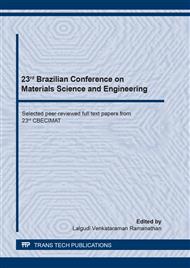p.89
p.94
p.100
p.109
p.114
p.119
p.125
p.131
p.136
Study of Supercapacitors for Use in Dye Sensitized Solar Cells
Abstract:
The storage of energy generated by photovoltaic system is one problem of it. In this aspect, integrated energy conversion and storage systems, IECSS, using supercapacitors are presented as a solution. Dye sensitized solar cell becomes a main candidate for use in IECSS due its variety of applications. Recent studies shown that zinc oxide (ZnO) is a natural candidate for use in solar cells and supercapacitor due to its high energy density of the order 650 A g-1. The aims of this paper were: i) the study of the influence of the morfology of nanostructured ZnO nanoparticles obtained by the hydrothermal method using distincts complexing agents: etylenediaminetetraacetic acid (EDTA); hexamethyltetramine (HMT) and diaminometanal (urea), besides commercial ZnO; ii) study of the ZnO and activated carbon at ratio X:Y of 10:90, 20:80 and 30:70 in proportion of mass (%) in the preparation of electrodes. The commercial ZnO, which presents particles with spherical and porous morphology, presented the best capacitance result 8.38 Fg-1 at 10:90 ratio, that demonstrates the ZnO is an excellent candidate for material for supercapacitor coupled with dye solar cell.
Info:
Periodical:
Pages:
114-118
Citation:
Online since:
October 2020
Keywords:
Price:
Сopyright:
© 2020 Trans Tech Publications Ltd. All Rights Reserved
Share:
Citation:


